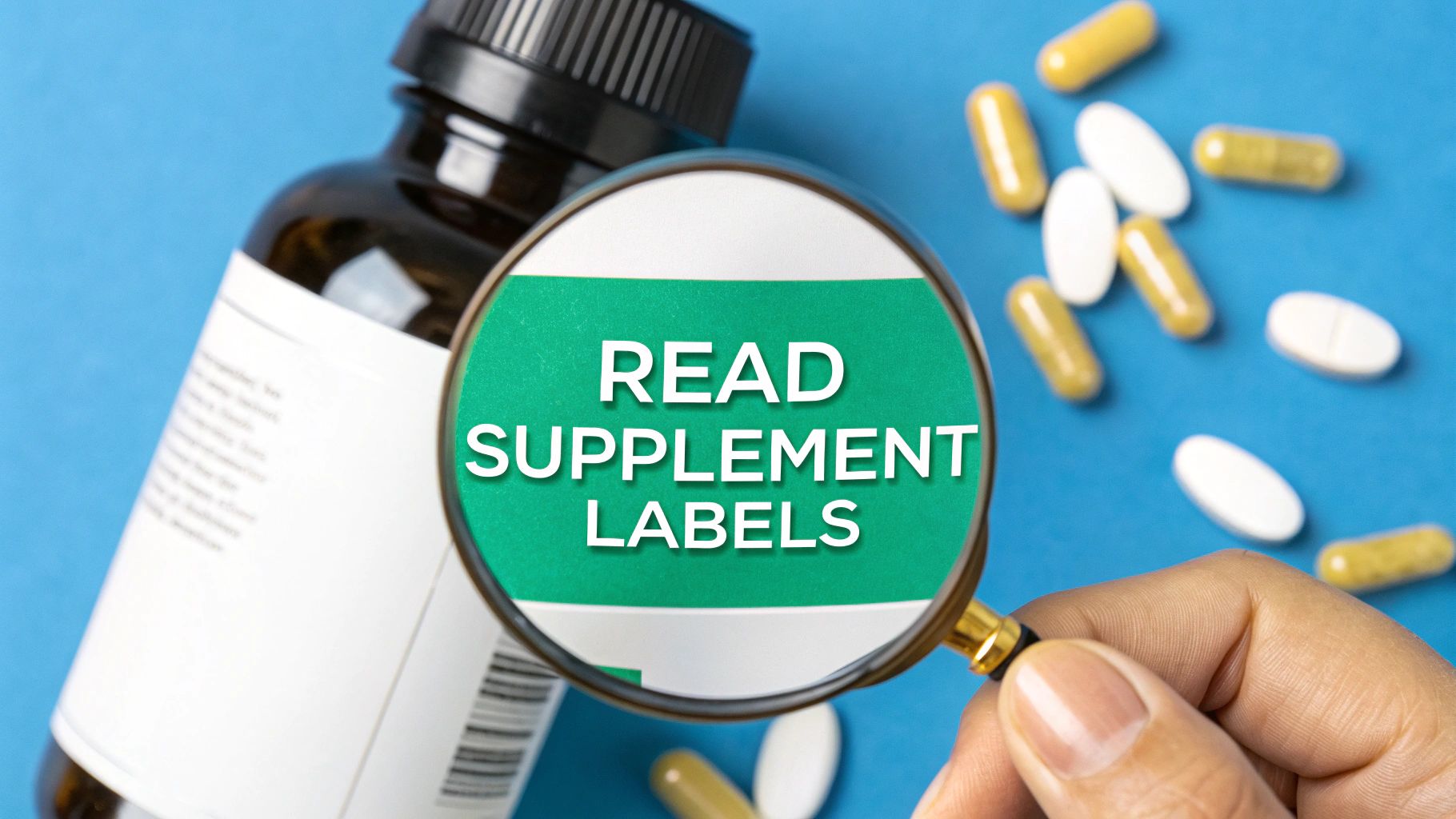

· By Annemarie
How to Read Supplement Labels and Make Smart Choices
Walking down the supplement aisle can feel like stepping into a linguistic labyrinth. Bottles scream bold claims, and the sheer number of options is enough to make anyone's head spin.
Learning to read a supplement label isn't just a neat trick; it's an essential skill for anyone serious about their health. Think of this guide as your personal translator, ready to turn that confusing wall of text into clear, confident decisions about what you're actually putting in your body.
The global market for dietary supplements has ballooned to an estimated $192.65 billion, which tells you just how many people are buying these products. Yet, while most American adults take some kind of supplement, studies show very few can accurately read the % Daily Value (%DV) on the label. That one little number is key to understanding how a product fits into your daily diet. You can read more about these consumer insights on supplement labeling right here.
Ditching Guesswork for Good
Once you get the hang of reading labels, you can finally see past the flashy marketing on the front of the bottle. It’s like having x-ray vision. Suddenly, you can:
- Verify the good stuff: Confirm you’re getting the right active ingredients in a dose that will actually work.
- Spot unwanted extras: Easily identify fillers, artificial colors, or potential allergens you’d rather avoid.
- Compare products like a pro: Make true apples-to-apples comparisons between brands to find the best value and formula for your needs.
- Check for safety and quality: Look for those all-important third-party seals that verify a product’s purity and potency.
By the time we're done here, you'll be able to dissect any supplement label with total confidence. You'll know exactly where to look, what all the numbers and jargon mean, and how to spot any red flags. This is how you go from being a passive consumer to a true advocate for your own health.
To give you a head start, here’s a quick-glance table breaking down the most important sections of any supplement label.
Key Sections of a Supplement Label at a Glance
| Label Section | What It Tells You | Why It's Critical |
|---|---|---|
| Serving Size | How much of the product equals one serving (e.g., 2 capsules, 1 scoop). | All nutrient amounts listed are based on this serving size. Mistaking it can lead to under-dosing or over-dosing. |
| Supplement Facts Panel | A detailed list of all active nutrients, vitamins, and minerals, along with their amounts per serving and % Daily Value (%DV). | This is the core of the label. It shows the potency and how the supplement contributes to your daily nutritional needs. |
| Ingredient List | Lists all ingredients in descending order by weight, including active nutrients and "other" inactive ingredients like fillers and binders. | Essential for spotting hidden allergens, unwanted additives (like artificial sweeteners or colors), and understanding the product's full composition. |
| Quality/Purity Seals | Certifications from third-party organizations (like NSF, USP, or Informed-Sport) that verify the product's contents and purity. | Provides independent assurance that what's on the label is actually in the bottle, and that it's free from contaminants. |
| Allergy & FDA Warnings | Specifies potential allergens (e.g., "Contains soy") and includes the mandatory FDA disclaimer for supplements. | Crucial for safety, especially for individuals with allergies or dietary restrictions. It also reminds you that the product isn't intended to cure disease. |
Getting familiar with these sections is the first step toward becoming a more informed consumer. Now, let’s dive into each one.
Mastering the Supplement Facts Panel
The Supplement Facts panel is the heart and soul of any supplement label. Forget the flashy marketing claims on the front for a second—this little box is where the real story is told.
Think of it as the product's nutritional blueprint. Getting comfortable reading this panel is probably the most important skill you can develop to make smart choices for your health.
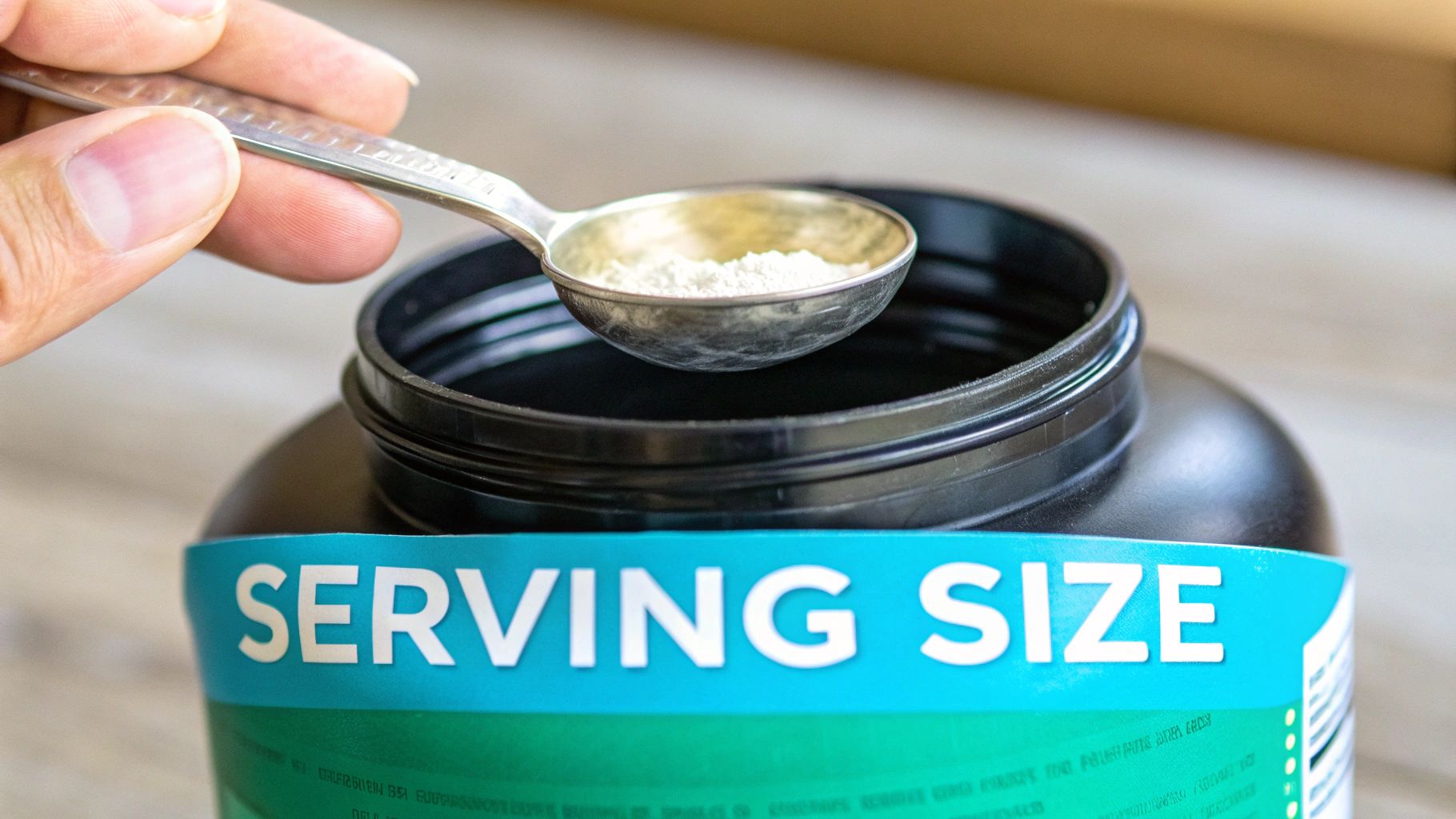
Let's walk through it, piece by piece. Once you know what you're looking at, it's not nearly as intimidating as it seems.
First Things First: Serving Size
Your eyes should go straight to the Serving Size at the very top. This is the foundation for every other number on the panel. It tells you exactly how much of the product—one capsule, two gummies, one scoop—counts as a single serving.
It’s a classic mistake to just glance at the total capsule count and think that’s your supply. A bottle might have 120 capsules, but if the serving size is four capsules, you've only got a 30-day supply. Always check this first so you know how much you're actually taking and how long the bottle will last.
Getting into the Nitty-Gritty: Amount Per Serving
Right below the serving size, you'll see the Amount Per Serving column. This is the good stuff. It lists the exact quantity of each active ingredient you get in one serving. The units might look technical, but they're pretty simple.
- mg (milligram): One-thousandth of a gram.
- mcg (microgram): One-thousandth of a milligram. You'll see this for really potent nutrients like B vitamins where a tiny amount goes a long way.
- IU (International Unit): This measures the biological effect, or potency, of fat-soluble vitamins like A, D, and E.
When you're exploring the various benefits of a Vitamin B complex, for example, you'll often see Vitamin B12 listed in micrograms (mcg). That's because it's incredibly effective even in minute quantities. Keeping an eye on these units is key to accurately comparing different products.
Making Sense of Percent Daily Value (%DV)
Over on the right side of the panel, you'll find the % Daily Value (%DV). This number tells you how much a nutrient in one serving contributes to a standard daily diet. It’s a handy reference point, but there’s a big "but" that comes with it.
The %DV is based on the needs of an average adult on a 2,000-calorie diet. Your personal needs could be completely different based on your age, sex, activity level, or health goals.
Think of the %DV as a general guideline, not a strict rulebook for your body. A value of 5% DV or less is considered low, while 20% DV or more is high. This can help you see at a glance if a supplement is just topping you off or providing a major dose.
Let's look at a real-world example to see how this plays out.
A Quick Look at a Vitamin D Label
Imagine you pick up a bottle of Vitamin D. The label might show:
- Serving Size: 1 Softgel
- Amount Per Serving: Vitamin D3 (as Cholecalciferol) - 50 mcg (2,000 IU)
- % Daily Value: 250%
Here’s how to read that:
- Serving Size: Easy enough. You just need one softgel to get the stated dose.
- Amount Per Serving: That one softgel delivers 50 mcg (or 2,000 IU) of Vitamin D3.
- % Daily Value: This single serving provides 250% of the daily recommended amount for an average person.
Seeing a %DV well over 100% can look a little wild, but it’s actually pretty common for certain vitamins, especially when you're trying to correct a deficiency. It's also a clear sign that this is a high-potency product, and it's a good reminder to consider whether a dose that high is actually right for you.
Looking Beyond the Nutrients to the Ingredient List
The Supplement Facts panel gives you the headliners, but the full ingredient list? That tells the rest of the story. This is where you find out everything else that’s in the bottle, from the main event down to the smallest additive. If you're serious about learning how to read supplement labels, you need to give this section just as much attention as the nutrient breakdown.
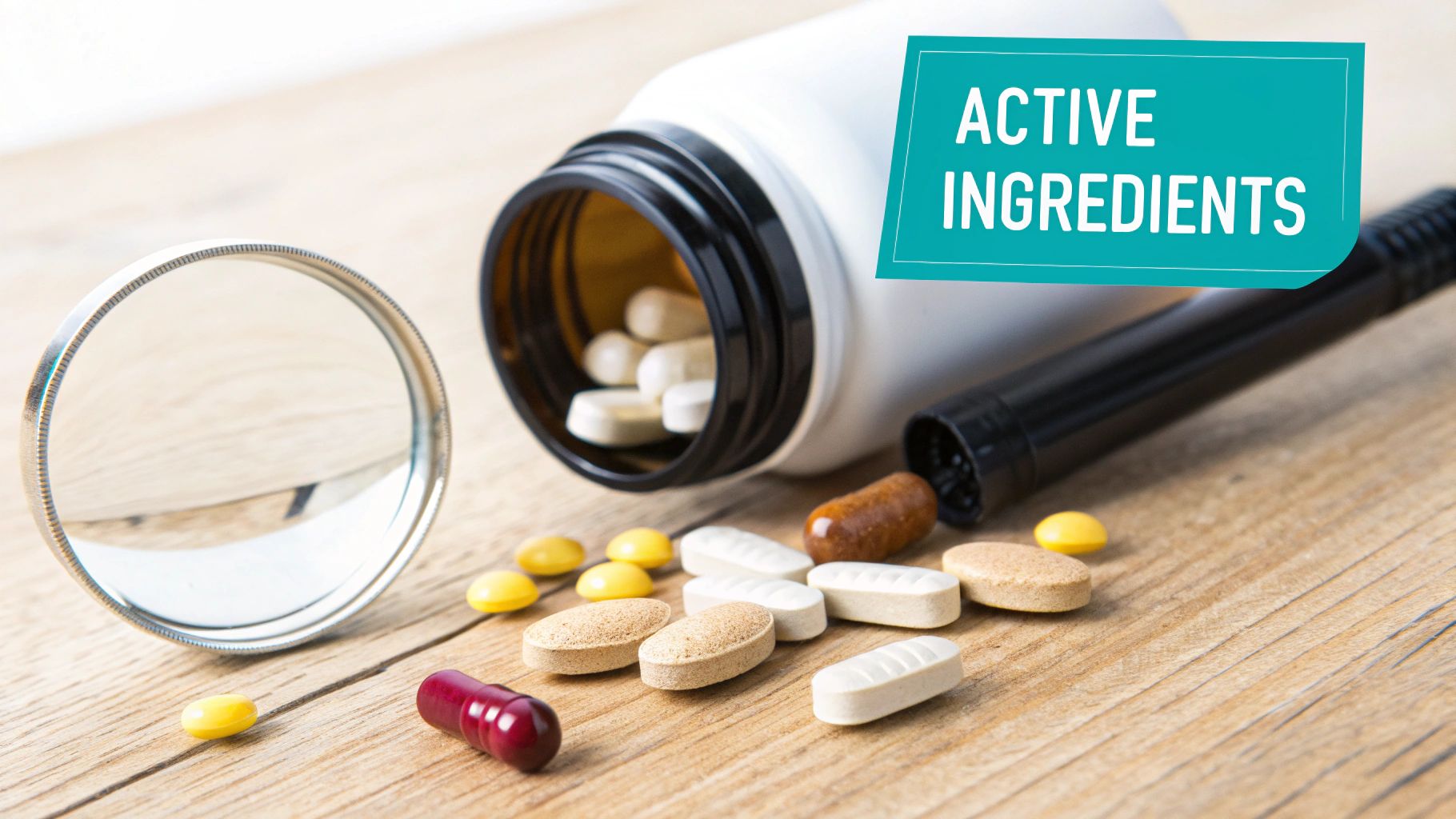
Here's the key: ingredients are always listed in descending order by weight. This means the stuff that makes up most of the product is right at the top, giving you a pretty clear picture of what you’re really getting.
The Mystery of Proprietary Blends
You’ve probably seen the term "proprietary blend" on supplement labels, especially with formulas for energy, sleep, or athletic performance. It's basically a brand's custom-created mix of ingredients.
While it sounds exclusive, it's often a major headache when it comes to transparency. The label will give you the total amount of the blend per serving, but it won't tell you the exact amount of each individual ingredient inside it.
For instance, a "Focus Blend" might be 500 mg total. But for all you know, it could be 495 mg of a cheap filler and only 5 mg of that powerful, effective ingredient they're advertising on the front of the bottle. This makes it almost impossible to know if you're getting a real, effective dose or just a sprinkle for marketing. It's a common red flag for anyone who cares about precise dosing and knowing what they're putting in their body.
Separating Active from Other Ingredients
Look below the main facts panel and you'll usually find a section labeled "Other Ingredients." Think of this as the supporting cast—the components that aren't the star nutrients but play a role in making the final product.
You’ll see things like:
- Binders: Ingredients like microcrystalline cellulose that hold a tablet together.
- Fillers: These add bulk to a capsule or tablet, making it a practical size to handle.
- Flow Agents: Stuff like magnesium stearate that stops ingredients from clumping during manufacturing.
- Flavorings and Sweeteners: You'll see these all the time in powders, gummies, and liquids.
Most of these are harmless and necessary for production. But some people prefer to avoid certain additives like artificial colors (e.g., titanium dioxide), preservatives, or specific sweeteners. This is also where you might spot potential allergens like soy, corn, or wheat that aren't listed in a separate "Contains" statement.
A clean, minimal "Other Ingredients" list is almost always a good sign. It usually means the manufacturer isn't relying on a bunch of unnecessary additives to create their supplement.
For those of us who value purity and transparency, understanding the full picture is everything. You can check out a great example of a clear breakdown of both active and inactive components by exploring the details behind Upside's intentionally chosen ingredients. Making smart choices means looking at the complete picture, not just the highlights on the front of the label.
Decoding Marketing Claims and Quality Seals
The front of a supplement bottle is prime real estate. It's designed to grab your attention with bold promises and sleek branding. While the Supplement Facts panel gives you the hard data, the front is all about marketing. Learning to see through the hype is a huge part of being a savvy supplement user.
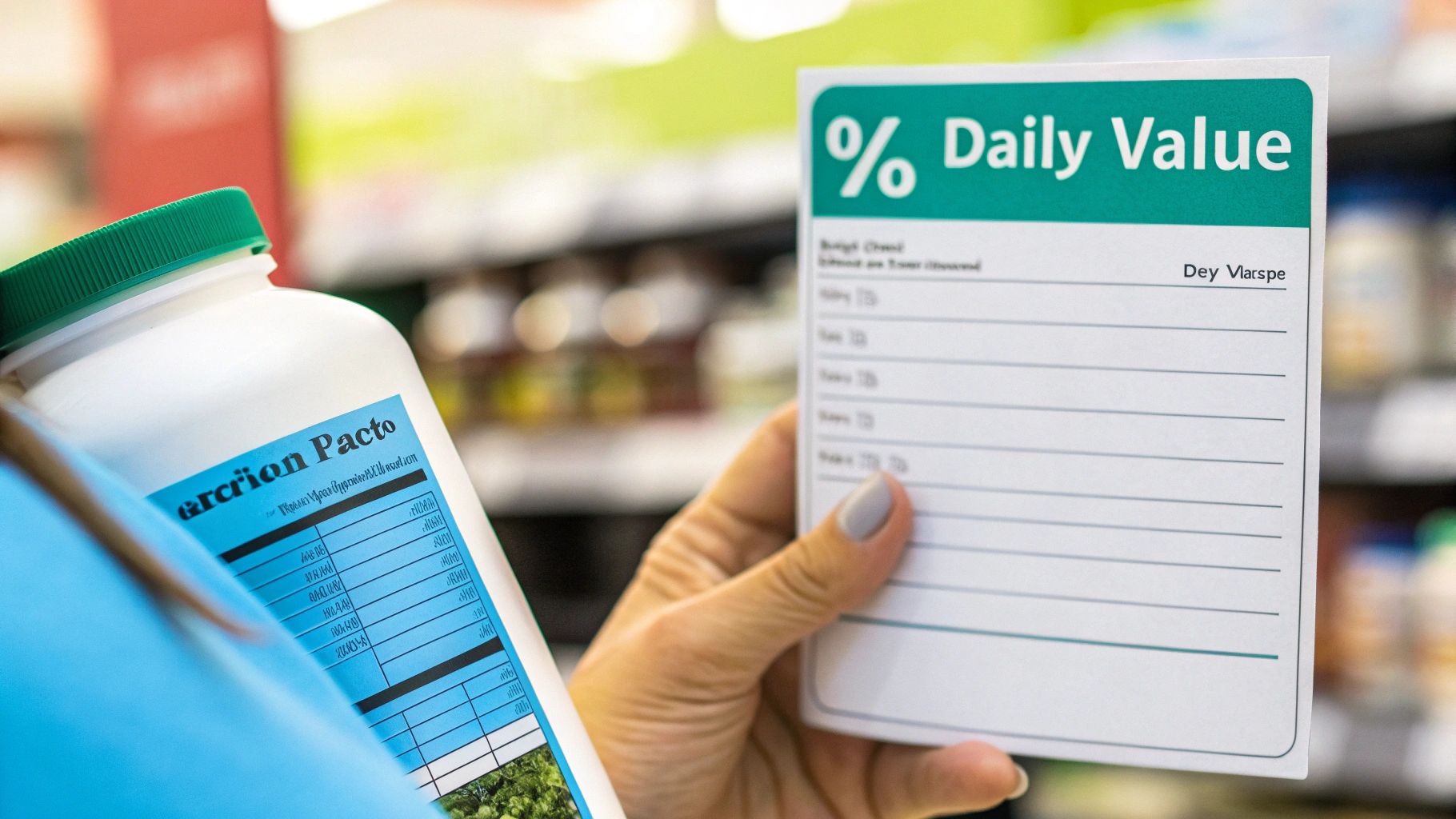
Now, the claims you see aren't totally unregulated, but they do live in a bit of a gray area. The trick is to understand the different types of claims the FDA allows so you can filter out the noise.
Understanding Different Label Claims
The FDA has a few specific categories for the statements brands can put on their labels. Once you know what they are, you'll start spotting them everywhere.
-
Nutrient Content Claims: These are the most straightforward. They're telling you about the level of a specific nutrient, using phrases like "High in Vitamin C" or "Excellent source of calcium." These are generally pretty reliable since they have to meet specific FDA definitions to be used.
-
Health Claims: These are much harder to get approved and require a ton of scientific evidence. They directly link a nutrient to a reduced risk of a disease, like connecting calcium intake to a lower risk of osteoporosis. You won't see these very often on supplements simply because the scientific bar is incredibly high.
-
Structure/Function Claims: This is what you'll see 99% of the time. These claims talk about how a nutrient affects the normal function or structure of the body. Think "Calcium builds strong bones" or "Supports a healthy immune system." They're perfectly legal, but they absolutely cannot claim to diagnose, treat, cure, or prevent any disease.
The Mandatory FDA Disclaimer
Because structure/function claims are so common, you'll almost always find this exact sentence on a supplement label: "These statements have not been evaluated by the Food and Drug Administration. This product is not intended to diagnose, treat, cure, or prevent any disease."
Don't let this scare you off. It's not a red flag; it's just a legal requirement. It's the brand's way of saying, "Hey, this is a supplement to support your health, not a drug to treat a medical condition." For a brand to make claims with real integrity, they need to back them up with transparent science, which is a core part of our approach to formulation at Upside.
Finding Trustworthy Quality Seals
So, if the FDA isn't vouching for a supplement's effectiveness, how do you know you're getting a quality product?
Look for seals from independent, third-party certifiers. These are your best bet for confirming that what's on the label is actually in the bottle.
A third-party seal is a voluntary step a company takes to demonstrate its commitment to quality and transparency. It’s an investment in consumer trust and a powerful sign of a reputable brand.
Here are the big ones to keep an eye out for:
- USP (United States Pharmacopeia): This seal verifies that the product has what it says it has, in the right amounts. It also confirms it’s free from harmful levels of contaminants and will actually break down in your body properly.
- NSF International: Similar to USP, NSF certification confirms that the label is accurate and the product is safe from contaminants. They also run a "Certified for Sport" program that screens for over 270 substances banned by major athletic organizations.
- ConsumerLab.com: This is an independent testing organization that buys products off the shelf and tests them. A seal from ConsumerLab.com means the supplement passed their tough quality and purity checks.
Consumers are getting smarter about what they put in their bodies. The nutritional labeling market is projected to jump from $25.4 billion to $36.2 billion over the next decade. This just shows how much people are demanding transparency and useful information, which is why the 'Supplement Facts' panel is a non-negotiable requirement from the FDA.
Putting Your Label Reading Skills into Practice
Alright, you've got the theory down. But knowing what's on the label is only half the battle. The real test comes when you're standing in the supplement aisle, faced with dozens of options, trying to make the right call. This is where we move from theory to action.
Let's say you're looking for a magnesium supplement. You see two bottles: one is Magnesium Oxide, the other is Magnesium Glycinate. The oxide version boasts a higher dose per pill, which might seem like the better deal at first glance. But now you know better. You flip it over, scan the ingredients, and remember that the form of the nutrient is just as important as the amount. You know that glycinate is much more easily absorbed by the body, making it a far more effective choice, even if the number on the front looks a little smaller.
Scrutinizing a Pre-Workout Formula
Now for a more complex product, like a pre-workout powder. The front of the tub is covered in flashy promises of "explosive energy" and "intense focus." But you're not falling for the hype. You turn it around to the Supplement Facts panel and immediately spot a huge "proprietary blend."
That’s your cue to dig deeper.
Inside that blend, you see a long list of stimulants, but with no individual amounts specified. This is a classic trick. It means you have no idea if you're getting a ton of caffeine and just a sprinkle of the other, more expensive ingredients. A quick look at the "Other Ingredients" list reveals a bunch of artificial sweeteners and fillers. Case closed—this isn't the clean, effective product you were hoping for.
This is how you go from being a passive consumer to an advocate for your own health. You stop being swayed by marketing buzzwords and start making decisions based on facts you can find and understand yourself.
This next image really drives home the point. It shows the trade-off you often see between a product loaded with the good stuff versus one that’s mostly fluff.
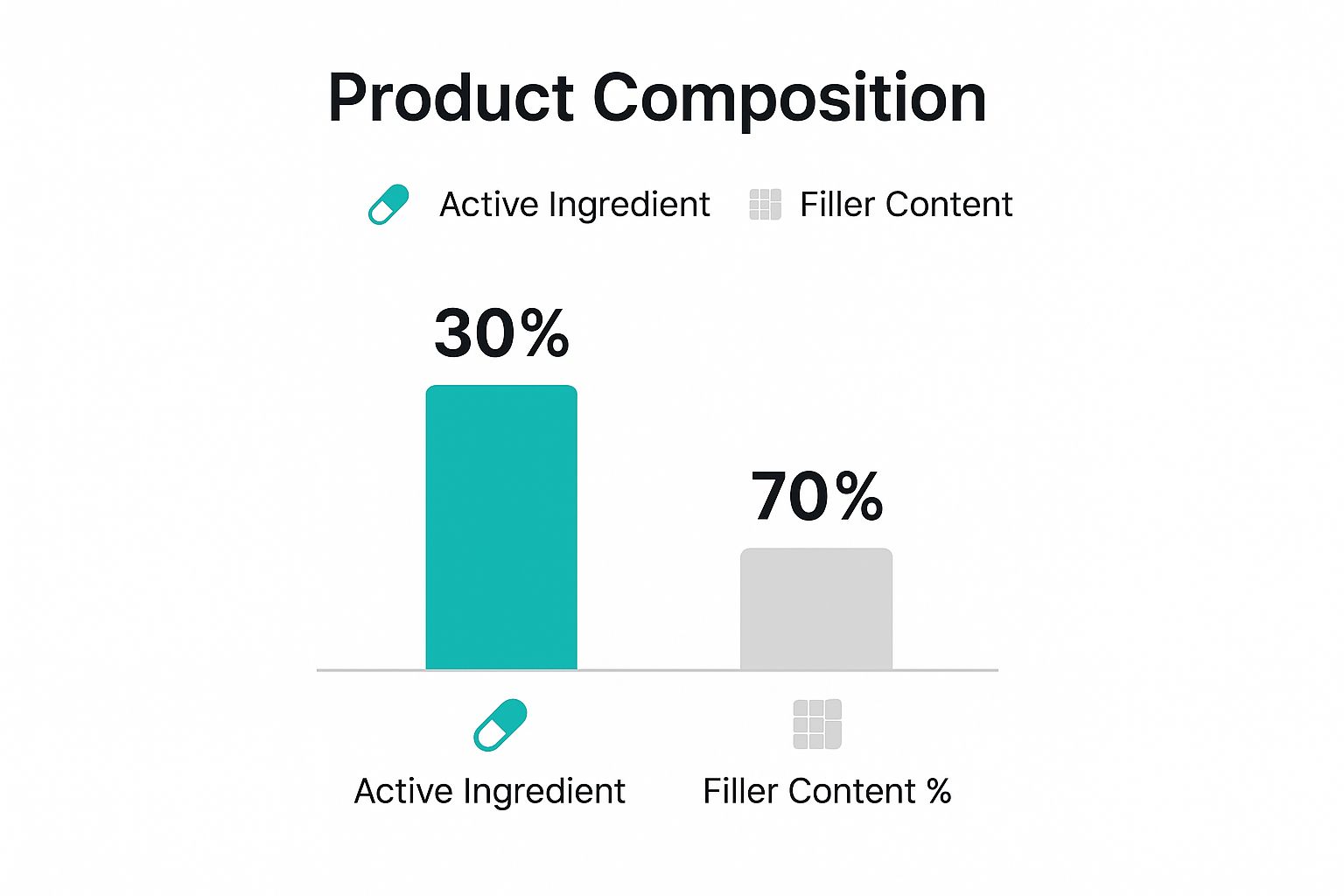
As you can see, some supplements are packed with active ingredients, while others dedicate a shocking amount of space to inactive fillers, which says a lot about the product's quality and value.
Meeting Specific Dietary Needs
This skill becomes absolutely essential if you have any dietary restrictions. Need something that's certified gluten-free or vegan? You'll know to ignore the claims splashed on the front and look for the official third-party seals on the back. Those little logos are your guarantee that the product has been rigorously tested and meets strict standards.
And this isn't just a local issue. The need for clear label education is blowing up globally. The Asia-Pacific region now accounts for over a third of the entire dietary supplement market. This means millions of new consumers are trying to decipher labels, often in different languages and under varying regulations. It just goes to show that mastering this skill is valuable no matter where you are. You can discover more insights about the growing global supplement market and see the full report.
To really bring this all together, let's compare two hypothetical Vitamin C supplements side-by-side. This is exactly the kind of mental checklist you can run through in the store.
Comparing Two Vitamin C Supplement Labels
| Feature | Supplement A (Basic) | Supplement B (Enhanced) |
|---|---|---|
| Active Ingredient | 1,000 mg Ascorbic Acid | 1,000 mg Ascorbic Acid |
| Form | Standard synthetic | Includes bioflavonoids for absorption |
| Other Ingredients | Microcrystalline cellulose, magnesium stearate, artificial colors | Vegetable cellulose, rose hips, acerola cherry |
| Allergen Info | "May contain soy" | "Free from common allergens" |
| Quality Seals | None | Third-party tested (USP seal) |
| Serving Size | 2 tablets | 1 capsule |
Looking at this table, Supplement A isn't bad—it delivers the Vitamin C. But Supplement B is clearly the superior choice. It uses natural co-factors to improve how your body uses the vitamin, has a cleaner ingredient list, provides clear allergen information, and has a trusted third-party seal to back it all up.
This is what informed consumerism looks like. It's about looking past the price tag and the front-of-label claims to find the product that truly delivers.
Got Questions? Let's Talk Supplement Labels
Even when you feel like you've got the hang of it, a few tricky questions always seem to pop up. Nailing down these final details is what separates a casual shopper from a truly informed consumer. Let's dig into some of the most common things people ask.
Serving Size Versus Servings Per Container
It's super easy to mix up 'serving size' and 'servings per container', but they tell you two completely different stories. The serving size is what the company suggests you take in one go—say, two capsules. Every single number on that nutrient list is based on that specific amount.
'Servings per container' is the big picture; it tells you how many of those servings you get in the whole bottle. You have to check both. A bottle might look like a steal, but if it only has 15 servings, it's not such a great deal compared to a competitor offering 60 for just a few bucks more.
Think of it this way: the serving size tells you what you're getting, but the servings per container tells you how long it'll last. Don't let a low price tag trick you into buying something that will be empty in two weeks.
What’s the Deal With High %DV?
Seeing a nutrient listed at over 100% of the Daily Value (%DV) can look a little scary, but it's not always a red flag. The %DV is just a general guideline designed to help the average person avoid a nutrient deficiency—it's not a personalized prescription for your unique health needs.
For water-soluble vitamins, like Vitamin C and all the B-vitamins, your body is pretty smart. It typically just gets rid of any excess it can't use. That's why you'll often see crazy high %DVs for these, and it's generally considered safe. You do want to be a bit more careful with fat-soluble vitamins (that’s A, D, E, and K), since your body can store them, and high doses can build up over time.
A high %DV is really just a heads-up to ask yourself if that dose makes sense for you and your goals. When in doubt, it’s always a good idea to chat about high-potency supplements with your doctor.
The Truth About "Natural" and "Organic" Claims
So what about those labels shouting "natural" or "organic"? While they sound like they must be better for you, these terms can be a bit of a marketing trap.
- Organic: This one is actually regulated. If you see the USDA Organic seal on a supplement, it means the ingredients were farmed according to strict federal guidelines. You can trust that one.
- Natural: This term, on the other hand, is pretty much the wild west. The FDA doesn't regulate its use on supplements, so it can mean anything—or nothing at all. It's often just a buzzword.
At the end of the day, neither term is a guarantee of a product's safety or effectiveness. The most reliable way to judge quality is still by looking at the Supplement Facts panel, the ingredient list, and checking for trusted third-party seals like USP or NSF.
Ready to party smarter without the morning-after regret? Upside has you covered. Our Hangover Jelly is your convenient, science-backed ally for enjoying your night and owning your morning.
Grab your Upside Hangover Sticks today and feel the difference!
#upside #enjoyupside #upsidejelly #livemore #hangovercure #hangoverprevention #fighthangovers #preventhangovers #HangoverRelief #MorningAfter #PartySmarter #HydrationStation #WellnessVibes #RecoverFaster #NoMoreHangovers #HealthyParty #HangoverHacks #FeelGoodMorning #NightlifeEssentials #HangoverFree #SupplementGoals #PostPartyPrep #GoodVibesOnly #HealthAndParty #HangoverHelper #UpsideToPartying
